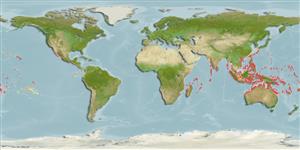Environment: milieu / climate zone / depth range / distribution range
Écologie
marin récifal; non migrateur; profondeur 1 - 25 m (Ref. 9710). Tropical; 32°N - 24°S
Indo-Pacific: East Africa south to Aliwal Shoal, South Africa (Ref. 4421) and east to Fiji, north to southern Japan, south to the southern Great Barrier Reef and New Caledonia. Recently recorded from Tonga (Ref. 53797). Replaced by Paraluteres arquat in the Red Sea.
Taille / Poids / Âge
Maturity: Lm ? range ? - ? cm
Max length : 11.0 cm TL mâle / non sexé; (Ref. 4421)
Description synthétique
Clés d'identification | Morphologie | Morphométrie
Épines dorsales (Total) : 2; Rayons mous dorsaux (Total) : 25 - 28; Épines anales: 0; Rayons mous anaux: 22 - 25. Ranges from pale greenish to dirty white in color; blackish-brown saddles above; normally with a round dark blotch above origin of anal fin; soft dorsal and anal fins hyaline, tips dusky; caudal fin yellowish (Ref. 4421).
Inhabit clear lagoon and seaward reefs to at least 25 meters (Ref. 5503). Solitary or in small groups (Ref. 9710). Adults usually in pairs, but sometimes seen in small aggregations (Ref. 48637). Mimic the poisonous puffer, Canthigaster valentini which it greatly resembles. Feed on eggs, gastropods and grazes the substrate (Ref. 5503, 48637).
Life cycle and mating behavior
Maturité | Reproduction | Frai | Œufs | Fécondité | Larves
Myers, R.F., 1991. Micronesian reef fishes. Second Ed. Coral Graphics, Barrigada, Guam. 298 p. (Ref. 1602)
Statut dans la liste rouge de l'IUCN (Ref. 130435: Version 2024-1)
Utilisations par l'homme
Outils
Articles particuliers
Télécharger en XML
Sources Internet
Estimates based on models
Preferred temperature (Ref.
123201): 25.2 - 29.3, mean 28.4 °C (based on 2764 cells).
Phylogenetic diversity index (Ref.
82804): PD
50 = 0.7500 [Uniqueness, from 0.5 = low to 2.0 = high].
Bayesian length-weight: a=0.01995 (0.00956 - 0.04164), b=2.93 (2.76 - 3.10), in cm total length, based on LWR estimates for this (Sub)family-body shape (Ref.
93245).
Niveau trophique (Ref.
69278): 2.7 ±0.44 se; based on food items.
Résilience (Ref.
120179): Haut, temps minimum de doublement de population inférieur à 15 mois (Preliminary K or Fecundity.).
Fishing Vulnerability (Ref.
59153): Low vulnerability (10 of 100).
Nutrients (Ref.
124155): Calcium = 91.9 [39.7, 238.6] mg/100g; Iron = 0.901 [0.405, 2.114] mg/100g; Protein = 17.9 [15.6, 20.1] %; Omega3 = 0.11 [0.05, 0.23] g/100g; Selenium = 27.5 [12.9, 64.2] μg/100g; VitaminA = 72 [20, 274] μg/100g; Zinc = 1.79 [1.13, 2.88] mg/100g (wet weight);
